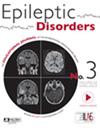凝胶痉挛发作:对一例额部病灶的视频脑电图和闪烁扫描分析;文献综述和病理生理学假设
IF 1.9
4区 医学
Q3 CLINICAL NEUROLOGY
引用次数: 0
摘要
我们报告了一名年轻患者的头皮脑电图和 SPECT 检查结果,该患者曾经历过凝胶样癫痫发作;临床、脑电图和闪烁成像数据均强烈提示该患者为隐源性癫痫的额叶病灶。起源于额叶的凝胶样发作病例在文献中鲜有报道,其中大多数涉及双脑仓瘤或颞叶病灶,但尚未发现这三个解剖区域各自特有的临床模式。发作性笑声的性质不一,有的没有动机,有的伴有欢乐的感觉,有的是被迫的,有的是自然的,只有额叶病灶的笑声似乎一直被描述为被迫的和没有动机的。然而,欢笑和大笑是两个不同的临床要素;它们的产生可能涉及不同的机制。从解剖学角度考虑,我们可以对笑的产生提出几种假设:笑可能是一种简单的反应行为,是对改变了的认知过程的反应,也可能是一种自动行为或强迫动作。在少数以颞叶为病灶的病例中,笑似乎与颞叶皮层的联想紊乱直接相关,可被视为一种反应行为。在额叶病灶的病例中,前扣带回和眼眶结构尤其与笑的产生有关,但其病理生理学途径可能不同:前者是由于前运动中枢系统内部的断裂或前运动中枢系统与前运动外侧系统之间的失衡,后者则是由于激活了先前的条件眼眶区域。本文章由计算机程序翻译,如有差异,请以英文原文为准。
Gelastic seizures: video‐EEG and scintigraphic analysis of a case with a frontal focus; review of the literature and pathophysiological hypotheses
We report scalp EEG and SPECT findings in a young patient who experienced gelastic seizures; clinical, EEG and scintigraphic data strongly suggested a frontal focus in a context of cryptogenic epilepsy. Few cases of gelastic seizures originating in the frontal lobe have been reported in the literature, most of them involving a diencephalic hamartoma or a temporal focus although, no clinical pattern has been found to be specific for each of these three anatomical regions. The ictal laughter is of variable nature, unmotivated or associated with feelings of mirth, forced or natural, except in the case of a frontal focus where the laughter seems consistently described as forced and unmotivated. However, mirth and laughter are two dissociable clinical elements; their genesis probably involves distinct mechanisms. Anatomical considerations lead to several hypotheses concerning laughter generation: it could be a simple reactional behavior in response to a modified cognitive process, an automatic behavior or a forced action. In a few cases with a temporal focus, laughter seems directly related to a disorganization of the associative temporal cortex and may be considered as a reactional behavior. In cases with frontal focus, anterior cingulate and orbital structures would be particularly implicated in laugher genesis, although with possible different pathophysiological routes: in the first case by disconnection within the premotor mesial system or by an imbalance between premotor mesial and premotor lateral systems, and in the second case by activation of a previously conditioned orbital region.
求助全文
通过发布文献求助,成功后即可免费获取论文全文。
去求助
来源期刊

Epileptic Disorders
医学-临床神经学
CiteScore
4.10
自引率
8.70%
发文量
138
审稿时长
6-12 weeks
期刊介绍:
Epileptic Disorders is the leading forum where all experts and medical studentswho wish to improve their understanding of epilepsy and related disorders can share practical experiences surrounding diagnosis and care, natural history, and management of seizures.
Epileptic Disorders is the official E-journal of the International League Against Epilepsy for educational communication. As the journal celebrates its 20th anniversary, it will now be available only as an online version. Its mission is to create educational links between epileptologists and other health professionals in clinical practice and scientists or physicians in research-based institutions. This change is accompanied by an increase in the number of issues per year, from 4 to 6, to ensure regular diffusion of recently published material (high quality Review and Seminar in Epileptology papers; Original Research articles or Case reports of educational value; MultiMedia Teaching Material), to serve the global medical community that cares for those affected by epilepsy.
 求助内容:
求助内容: 应助结果提醒方式:
应助结果提醒方式:


